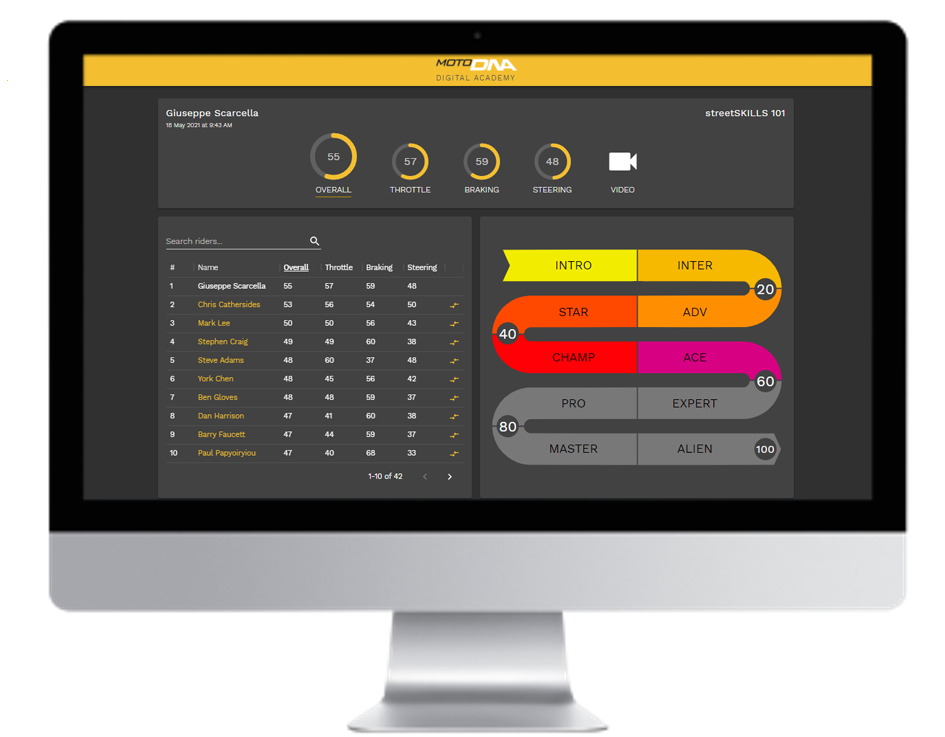A topic that gets plenty of discussion at motoDNA is counter steering. What is this mythical counter steering? How does it work?
The definition of counter steering is initiating a turn by pushing on the inside handlebar to lean a bike into a corner. Simply, push left to go left and push right to go right.
Counter steering generally works at speeds above walking pace due to the dynamics of the bike and is the primary method used to steer a motorcycle.
To truly understand how counter steering works requires some Engineering knowledge of trail, centripetal forces, gyroscopic precession, etc that we won’t discuss today.
Keep It Simple
But do we really need to understand the physics to effectively counter steer? Well, for most riders the answer is no. At motoDNA, we find most students simply over think counter steering.
Don’t try to be an Engineer, just accept that Newton’s laws have been around for a while and they work. Most riders counter steer subconsciously with out even thinking about it, the handlebar input barely noticeable.
However there are some things you can do to counter steer more effectively.
Body position and bio-mechanics …
The Basics
Your arms should be relaxed and parallel to the ground so you are pushing close to 90 degrees to the steering axis rather than pushing down on the handlebars. This has a number of benefits.
The road surface can be bumpy with potholes, camber, etc which causes the steering and handlebars to move around.
If your arms are too stiff you are effectively fighting against the bike. We need to allow these small movements at the handle bar without over riding the bike.
If you are too stiff on your bike, your body movements can also have undesirable steering inputs.
These front-end shakes will transfer through your whole body, which will act as extra inertia on the steering system reducing the bikes self-aligning effect and turning performance.
Understand Your Bike
Motorcycles generally want to go in a straight line. The steering geometry, rotating wheels, crankshaft, gears, etc give the bike that stability.
Relaxing your arms also results in less fatigue, as you are not fighting the movement that is normal at the front end of the bike.
To relax your arms effectively you need to hold onto the bike with other areas of your body. Focus on anchoring yourself on the bike with the inside of your legs.
Also use the heel of your boot to lock your feet on the peg.
Other than using foot controls, only move your feet position if you need ground clearance. You shouldn’t be riding around with your toes on the foot peg.
A seat pad is also good to stop you sliding back in the seat under acceleration and inadvertently pulling on the bars.
Feel The Force
When you are cornering on a bike, you are balancing the cornering force and gravity by adjusting your speed and lean angle. When you lean the bike, gravity wants to pull the bike towards the ground.
Cornering force, commonly thought of as centrifugal force, is dependent on your speed and will try to keep the bike upright.
Push on the inside bar and the bike leans. How quickly you push on the bar will determine the roll rate of the bike and how quickly the bike leans into the turn.
The longer you hold the pressure on the bar the further the bike will lean over. When you get to your desired lean angle you release pressure on the bar and the bike will hold its line with minimal input.
Have A Plan
Before you corner you should be planning the turn. Think about braking, turn in, apex and exit points. This will help you become smooth, one corner flowing to the next.
When your arms are relaxed you have a better chance of feeling what the front tire contact patch is doing. Racers use this technique to help control front end slides.
Its important to understand your bike so that counter steering becomes intuitive in case you need to take avoiding action one day. Like most skills, the more quality training and practice you do the better a rider you will become.
So drop your elbows and let the steering do it’s own thing.
Questions on counter steering ? Ask away in the comments below.
Practise Makes Perfect
There’s so many ‘experts’ and fragmented advise online these days, so its super important to learn the correct techniques and then do lots of practise.
As with all motorcycle training, practise in a controlled environment with 5% stretch goals step by step until the new skill is intuitive, then you know you’ve levelled up your riding.
Hungry for more knowledge ? Sign up to our newsletter
About the Author: Mark McVeigh
Data Driven
Developed from thousands of riders at the motoDNA Motorcycle Training, our algorithms measure, grade and train motorcycle riders.
Objective
No more guessing, data sensor fusion combined with our algorithms deeply understand rider behaviour.
Towards Zero
Our urgent and ambitious aim is to empower the motorcycle community to take back control towards zero.


